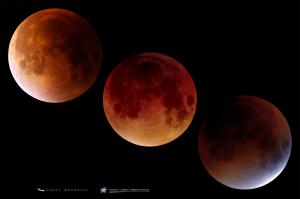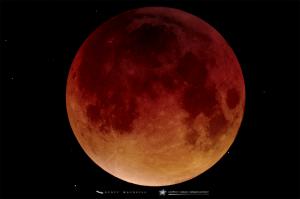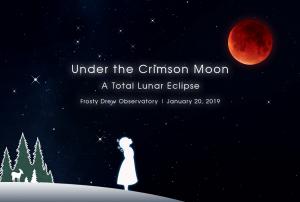
Stargazing Nights
- Where:
- Frosty Drew Observatory
- When:
- Friday January 11, 2019 at 7:00 p.m
- Cost:
- $5 Suggested Donation per person 5 years and older
Frosty Drew Observatory Stargazing Nights. Friday, January 11, 2019 7:00 p.m.
Tonight is Stargazing Night and forecasts are calling for clear skies all night long. Visibly, it will be a fabulous night, with the 35% waxing crescent Moon hanging softly in the southeast sky, with a subtle display of Earthshine, which is when we can see the nighttime side of the Moon alongside the crescent. Temps will be cold, in the low 20’s, and winds will be a bit blustery, with sustained winds around 10mph and gusts upwards of 25mph. Gusts that high will push our equipment tolerances, and may restrict viewing to only one side of the sky. We can work with the wind, though already cold temps will be exacerbated by that steady wind, bringing wind chills into the low teens. Dressing adequately will make all the difference tonight! Read up on how the astronomers at Frosty Drew Observatory dress.
We will open the Observatory and Sky Theatre at 7:00 pm tonight. In the Observatory, telescopes will start off with views of the crescent Moon, followed by the fantastic Orion Nebula. As the night progresses we will direct our telescopes towards the Messier 46 open star cluster, the Eskimo Nebula, and more. If winds are acceptable, courtyard telescopes will showcase the Andromeda Galaxy, the Pleiades, the Perseus Double Cluster, the Beehive Cluster, and Comet 46P/Wirtanen. In the Sky Theatre, the heat will be on, offering a break from the cold of a New England winter’s night, with our regular feature of celestial objects photographed at Frosty Drew Observatory on screen. We’ll stay open until 11:00 pm.
Overall, tonight looks like a true geek out. We’ll have clear skies, a sexy crescent Moon, and dark enough skies to rock out with numerous deep sky objects. Temps will be cold and the wind will make it bitterly cold, though winter happens in New England. So bundle up with a wind breaking parka, boots, gloves, and a hat; all are required tonight, then head out to Frosty Drew Observatory for a fabulous night under the winter starscape, and set your inner geek lose.
--------------------------
Weekly Happenings
Scott MacNeill
Overnight Sunday, January 20 – Monday, January 21, 2019, a fabulous Total Lunar Eclipse is happening over North and South America. In Southern New England, we will have a perfect view of the event, with maximum eclipse happening almost due south! This will place the entire eclipse event well above the horizon for our location. The hype is starting to kick in full swing, and though special glasses are not going to make this event any more accessible, the craziness that precedes eclipses is certainly looming.
A total lunar eclipse happens when the Moon passes into Earth’s primary shadow, called the Umbra. For this to happen, the Moon must be on the opposite side of Earth than the Sun. We can call this Opposition, Syzygy, or in regular terms – the Full Moon. Earth has two shadows, the penumbra – which is a partially shaded area where some sunlight is blocked by Earth, and the umbra – which is the region visible from the night side of Earth where all sunlight is blocked by Earth. Since the Moon does not orbit Earth on the same plane as Earth’s equator (23.4° inclined to the plane of the Solar System), we do not see eclipses every 29.5 days (synodic period of the Moon). Instead, the Moon orbits Earth inclined 5.1° to the plane of the Solar System. As a result, the Full Moon usually occurs above or below Earth’s shadows, with up-to four Full Moons per year interacting with Earth’s shadows in some capacity (penumbral, partial, or total eclipse).
Like all total lunar eclipses, the coming January 20-21 eclipse will play out in stages. From a Northern Hemisphere perspective; the first stage happens when the Moon enters Earth’s penumbra at 9:36 pm EST, which will be visible as a slight dimming of the left hemisphere of the Moon, that grows more intense over a period of about 56.5 minutes. The second stage starts when the Moon enters the umbra at 10:33 pm EST, this is the partial eclipse stage, and is visible as a missing chunk on the left hemisphere of the Moon that eventually overtakes the entire Moon over a period of about 67 minutes. This starts the third stage – the total eclipse stage at 11:41 pm EST, which is when the Moon is completely immersed in Earth’s umbra, this is also the stage of the eclipse when the Moon shines an eerie crimson red. The total eclipse stage will last about 62 minutes. Stage four, the partial eclipse stage, is when the Moon starts to exit Earth’s umbra at 12:43 am EST, and will appear as a bright chunk of the right hemisphere of the Moon, which increases over a period of 67.5 minutes, eventually exposing the entire visible area of the Moon. The fifth stage is when the Moon starts to exit Earth’s penumbra at 1:50 am EST, after which the eclipse is complete and we are left with a bright Full Moon.
The deep red color that the Moon takes on during the total eclipse stage, is certainly one of the most striking parts of the eclipse. The red coloring happens due to a process on Earth called Rayleigh Scattering, which is the scattering of blue light in Earth’s atmosphere. This is also the cause of red sunsets/sunrises, and red Moon rises. As sunlight enters Earth’s atmosphere it encounters molecular oxygen and nitrogen, which scatter the shorter wavelengths of light (blue side of the visible spectrum). This scattered blue light remains in the atmosphere, and is the cause for the blue sky. The longer wave lengths (red side of the visible spectrum) pass through Earth’s atmosphere. When looking at a red Sun setting or a red Moon rising, you are observing a source of sunlight though maximum atmosphere, resulting in maximum scattering of blue (and some green) light. The non-scattered red light is what you primarily see. During a total eclipse, sunlight refracts through Earth’s atmosphere and onto the Moon. Though all blue light and most green light is scattered in Earth’s atmosphere, only the red light makes it to the Moon.
Over the past few years, the term “Blood Moon” was popularized. This is a religious term associated with alleged doomsday prophecies, which references four total lunar eclipses consecutively, called a Lunar Tetrad, during a specific time, as a harbinger of doom. At Frosty Drew Observatory we do not generally use the term Blood Moon to describe a total lunar eclipse due to the doomsayer association related to the term. An eclipse is a fascinating natural occurrence that we get to experience periodically during our time on Earth. I think we should celebrate these events as highlights in our lives, not fear them as unproven harbingers of doom.
Aside from all the awesome of observing a total lunar eclipse, you also have the dark sky bonus. Which is when viewing the eclipse from a super dark location, free of excessive light pollution, like Ninigret Park (home to Frosty Drew Observatory), you will experience thousands of stars becoming visible during the total eclipse stage. At that time, the Moon will dim enough to allow for the type of starscape you would expect on a moonless night. At Frosty Drew Observatory, no only will thousands of stars shine, but also the winter time Milky Way will be visible just to the west of the red Moon. This will set us up for an unspeakably beautiful view of the night sky.
Timing is everything with celestial events, and we are placed quite fantastically with this eclipse. Not only in viewing times for our locations, but also in dates. The Monday following the eclipse (January 21, 2019) is Dr. Martin Luther King Jr. Day in the United States, which places this event on a holiday weekend with nearly all students having Monday off of school. A warm summer night may have been the candy on the apple, but I’ll take solace in the lack of mosquitoes experienced in January. Check out our event page for information about our celebration, and make plans to be out under the stars that night. While your at it, check our our gallery of the last Total Lunar Eclipse at Frosty Drew Observatory. Being that this is the last total lunar eclipse for us in New England until May 16, 2022, it is not a night to skip. So dress up, pack a snack, blanket, something toasty warm to drink, friends and family, and set out for night with one of the most beautiful celestial happenings for Earth-bound viewers, complements of the Solar System!
-Scott




